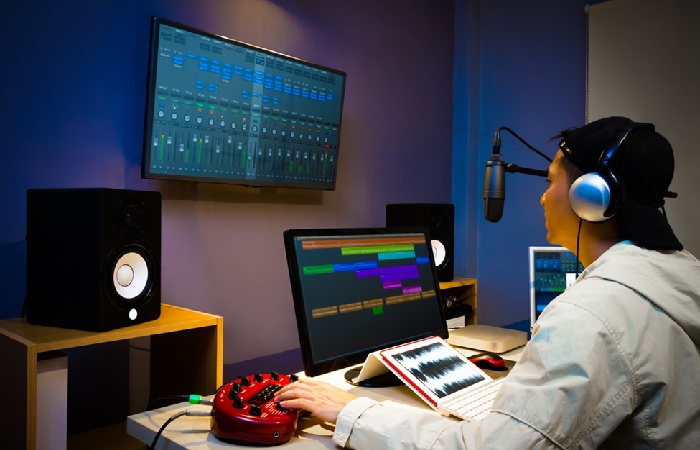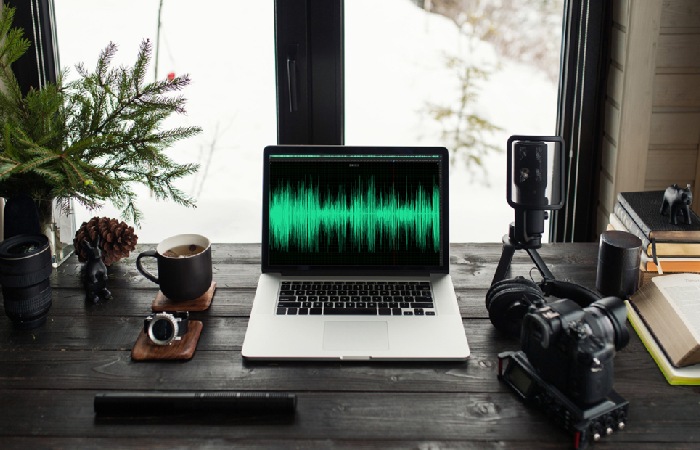Podcasts are a powerful medium for sharing ideas, stories, and information. From popular true-crime thrillers like Dark Downeast to news, sports, and entertainment juggernauts like Club Shay Shay, there is a podcast genre that appeals to all listeners. However, a podcast’s success is not solely dependent on its content but also on the caliber of its production.
Podcast editing is essential for ensuring your content is clear, engaging, and consistent, helping you attract and retain listeners and grow your channel. To create your perfect podcast, you need to do more than use a high-quality streaming setup. You must also learn how to edit a podcast. Read on to discover helpful tips and steps to edit a podcast.

Table of Contents
Tools and Software Options for Editing
Before beginning editing, ensure you have the tools and software available. To use them effectively, you’ll need to explore their various features and decide which ones are most suitable for your type of podcast.
- A free and open-source audio editing software known for its user-friendly interface and versatile editing capabilities.
- Adobe Audition. A professional-grade audio editing software with many features, suitable for beginners and experienced editors.
- A Mac-exclusive software ideal for beginners with its intuitive interface and basic editing functions.
- A highly customizable and affordable digital audio workstation (DAW) catering to music and podcast editing needs.
- Designed specifically for podcasters, it offers streamlined editing tools and automation for easy podcast production.
Editing Process: A Step-by-Step Guide
The podcast editing process starts with importing your recorded audio tracks into your selected software. Properly organize them, create a dedicated folder for each episode, and confirm that you have all the audio files, including interviews, narration, and additional elements like music and sound effects. Once you have all your recorded elements ready, you can begin refining your podcast.

Basic Editing Techniques
Whether you’re a beginner or looking to refresh your skills, understanding the basics of audio editing can help you create a polished final podcast that appeals to your audience. Some essential podcast editing techniques include:
- Trimming and cutting. Start by removing unnecessary content, such as long pauses, mistakes, or irrelevant tangents. Use the cut and delete functions to trim the audio.
- Adjusting volume levels. Ensure all audio tracks have consistent volume levels, especially when using multiple microphones. Use the software’s volume adjustment tools to balance the levels between different speakers or segments.
- Balancing tasks. If you have multiple tracks, adjust the balance to ensure that no one’s voice is too loud or soft compared to others.
Advanced Editing Techniques
After you have mastered the basic levels of editing, you can use more advanced techniques to make your podcast stand out from others.
- Noise reduction. To improve overall audio quality, use noise reduction tools to eliminate background noise, such as reverb, hums, hisses, or echoes.
- Apply equalization to enhance the clarity of voices and music. Adjust frequencies to make voices more natural and balanced.
- Adding effects. Incorporate audio effects like compression or equalization to create a polished and professional sound.
Inserting Additional Elements
As your knowledge of editing progresses, you can add more personal elements to your podcast that relate to your topic or your audience, such as:
- Integrate background music or theme music to add depth and ambiance to your podcast. Ensure it complements the content and doesn’t overpower voices. You can find a huge range of copyright-free music online at sites like PremiumBeat and Epidemic Sound.
- Sound effects. Enhance storytelling and engagement by including sound effects when appropriate. These can make your podcast more immersive and entertaining. Search through FX libraries at sites like ZapSplat and Freesound Project.
- If you have sponsors or advertisements, insert them strategically without disrupting the flow of your podcast. Use transitions like short verbal cues such as “and now, a quick word from our sponsor” to smoothly integrate ads.
Post-Editing Enhancements
Even though you started with trimming and cutting and volume levels, you will still need to make sure everything works together smoothly, including your personal intro and outro.
- Adding intro and outro. Create a distinctive intro and outro for your podcast. These elements help brand your show and make it more recognizable to listeners. They should be no longer than about 30 seconds and include a catchy tagline or slogan to help your podcast stand out.
- Incorporating transitions. Use transition effects or music to smoothly connect different segments or topics within your podcast, providing a seamless listening experience. Ensure they’re only a couple of seconds long and subtle so they don’t overpower the rest of your content.
- Finalizing the audio quality. Review and fine-tune the audio quality to ensure it meets professional standards. Check for any remaining background noise or inconsistencies.
Exporting and Publishing
Knowing how to export and where to publish the content is important. If you plan to publish on multiple platforms, export your podcast into the appropriate format.
- Choosing the proper file format. Select an appropriate audio file format for your podcast, such as MP3 or WAV. Ensure the file is compatible with your chosen podcast hosting platform.
- Exporting your podcast. Export the edited podcast in the chosen format, making sure to save a high-quality version for uploading.
- Uploading to podcast platforms. Upload your podcast to hosting platforms like Libsyn, Podbean, or Spotify for Podcasters (formerly Anchor). Create an eye-catching podcast cover image and write compelling episode descriptions to attract listeners.

Create a Professional Quality Podcast to Reach More Listeners
Podcast editing is a skill that can impact the success of your show. By following our step-by-step guide and maintaining brand consistency across every episode, you can create a professional-quality podcast that engages listeners and leaves a lasting impression.
Podcast editing helps deliver a clear, engaging, and consistent listening experience. With the right content creator equipment, software, and a structured editing process, you can transform raw recordings into professional-quality podcasts that captivate listeners.

